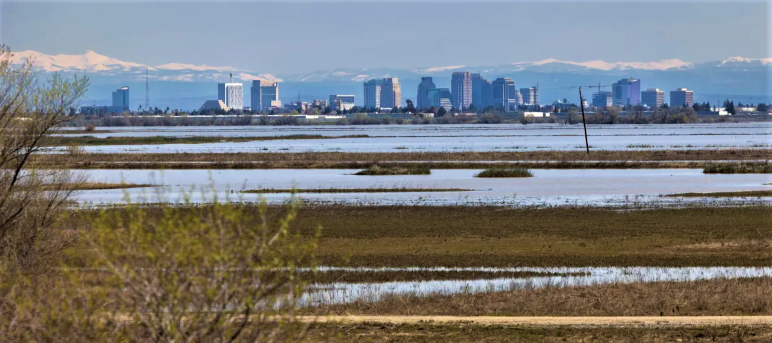Four months ago, Gov. Gavin Newsom yanked $40 million in funding to restore San Joaquin Valley floodplains from his proposed budget, angering legislators from both parties and conservationists. On Thursday, he gave all of the money back as part of a $290-million package to increase flood protection funding statewide.
The funding comes in addition to $202 million already included in Newsom’s 2023-24 budget proposal in January. That makes a total of $452 million in investments that Newsom is proposing to protect Californians from flooding in the wake of winter storms that inundated towns in the San Joaquin Valley and the Central Coast.
“California is facing unprecedented weather whiplash — we just experienced the driest three years on record, and now we’re dealing with historic flooding,” Newsom said in a written statement released May 11. “Our investments must match this reality of climate-driven extremes. We’re committing even more resources to support communities up and down the state as they continue responding to the impacts of this year’s storms.”
The governor’s revisions included changing $125 million in drought contingency funds into flood contingency funds, a response to the rapid turn from drought to deluge.
The revisions also include $75 million for local flood control projects, $25 million in grants to small agricultural businesses affected by the recent storms and $25 million for “potential additional disaster relief and response costs.”
The restored floodplains funding comes after widespread criticism from an unlikely alliance of bipartisan legislators, local leaders and conservationists in the San Joaquin Valley. They all said the cuts jeopardized the region’s low-income, disadvantaged farm towns and the city of Stockton.
Restoring floodplains — which usually involves removing or notching levees so that swollen rivers can spread across uninhabited land, as rivers naturally do — is considered one of the most cost-effective ways of reducing flood impacts on communities. Inundated floodplains also provide habitat for fish and other wildlife and help recharge groundwater basins for farms and communities.
Both Democrats and Republicans in the Legislature — often at odds when it comes to water and ecosystem management — expressed dismay when Newsom clawed back the $40 million for floodplains. At the time, Resources Secretary Wade Crowfoot said the budget cut was the result of the state’s $22.5 billion deficit, adding that it was “not easy because we’re cutting priorities.”
Republican Assemblymember Heath Flora, whose district includes the northern San Joaquin Valley, was among those frustrated by Newsom’s January budget cut. He said parts of the Central Valley “are traditionally the last ones at the table when it comes to funding.”
Today Flora said the governor’s action restores “faith in a lot of us that the governor cares…The governor should be complimented on doing the right thing and hearing our concerns.”
In March, Assemblymember Adam Gray, a Democrat from Merced who rallied for floodplain restoration work in the valley, said the governor’s proposed $40 million cut demonstrated inequality in how the state distributes assistance.
The floodplain money will probably be allocated to the nonprofit River Partners, which was named in last summer’s budget as the recipient of the $40 million. The group’s projects were considered “shovel-ready” when Newsom cut the funding.
“The governor should be complimented on doing the right thing and hearing our concerns.”
As much as 600 acres of land could be reconnected to adjacent waterways in the next six months, according to Julie Rentner, River Partners’ president. “It will go fast, and the impacts will be measurable and tangible,” Rentner said.
With an El Niño predicted later this year bringing the possibility of another wet winter, time is of the essence to complete these restoration projects. Rentner said she and collaborating groups are seeking matching funding from federal agencies.
“There’s tremendous opportunity right now to see how an investment of this magnitude could be amplified with federal investment,” she said.
Barbara Barrigan-Parrilla, executive director of Restore the Delta, an environmental justice group in Stockton, also applauded the governor’s action. Scientists say the San Joaquin Valley could experience cataclysmic flooding in the near future.
“The governor listened to the multitude of voices that have called for the restoration and expansion of flood protection funding,” she said. “He did the right thing for Californians.”
She said much more money for flood protection work is needed, citing a report from state flood officials who estimated that $3.2 billion in state-federal funding over the next five years is needed to protect against catastrophic flooding in the Central Valley. According to that report, the state has spent just $250 million a year on flood protection.
“We’re still not where we need to be,” she said. “That may take work through several state budgets to get fully adjusted, but more will have to be done to prepare for climate change,” Barrigan-Parrilla said.
Rentner also said “the $40 million is a downpayment on what we need to get going.”
The revised budget must still be approved by the Legislature.
But Flora said he doubts at this point the floodplain restoration money would fail to reach the final budget, which comes later this summer. “It seems by now that this is a priority,” he said.
Sen. Melissa Hurtado, a Democrat from Bakersfield, said she is “committed to advocating for this funding’s inclusion in the final draft of the state budget” to help ensure that “communities of the Central Valley are safe from future flooding.”
Hurtado said the new funding will make “an important difference as continued snowmelt causes waterways throughout the Central Valley to continue rising and endangering our economic recovery efforts.”
Alastair Bland is a reporter with CalMatters.

